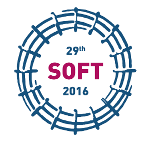Speaker
Hexiang Wang
(Mechanical Engineering & Mechanics)
Description
Ongoing work in the fusion community focuses on developing advanced plasma scenarios characterized by high plasma confinement, magnetohydrodynamic (MHD) stability, and noninductively driven plasma current. The toroidal current density profile, or alternatively the q profile, together with the normalized beta, are often used to characterize these advanced scenarios. The development of these advanced scenarios is experimentally carried out by specifying the device’s actuator trajectory waveforms, such as the total plasma current, the plasma density, the auxiliary heating and current-drive (H&CD) sources based on trial-and-error basis. In this work, a model-based numerical optimization algorithm is developed to complement the experimental effort of actuator trajectory planning in the EAST tokamak. The evolution of the q profile is closely related to the evolution of the poloidal magnetic flux profile, whose dynamics is modeled by a nonlinear partial differential equation (PDE) referred to as the magnetic-flux diffusion equation (MDE). In this work, the MDE is combined with physics-based correlations obtained from EAST experimental data for the plasma density, temperature, resistivity and non-inductive current drives to develop a control-oriented nonlinear PDE model. The optimization objective is to design feedforward trajectories for the plasma current, density, electron cyclotron heating, neutral beam injection and lower hybrid current drive that steer plasma to desired q profile and bN such that the achieved state is stationary in time. The optimization is subject to the plasma dynamics (described by the physics-based PDE model) and plasma state and actuator constraints, such as the maximum available amount of H&CD power and MHD stability limits. This defines a nonlinear, constrained optimization problem that is solved by employing sequential quadratic programming. The optimized actuator trajectories are assessed in nonlinear transport simulations in preparation for experimental tests in the EAST tokamak.
This work has been supported by the US Department of Energy under DE-SC0010537.
Co-authors
Eugenio Schuster
(Mechanical Engineering & Mechanics, Lehigh University, Bethlehem, United States)
Hexiang Wang
(Mechanical Engineering & Mechanics, Lehigh University, Bethlehem, United States)

